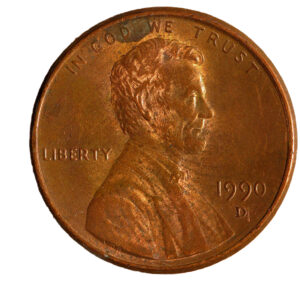President Trump has ordered the U.S. Mint to stop producing pennies. The reason is that it’s too costly to produce them. It costs the Mint nearly four cents to produce one penny.
The penny phenomenon is good example of what the federal government — and, specifically, the Federal Reserve — has done to our money. Ever since the Fed and a paper-money system were established in 1913 and the 1930s, the Fed has destroyed the value and stability of American money.

Licensed under the Creative Commons Attribution-Share Alike 2.5 Generic license.
For more than 100 years, the official money of the United States was gold coins and silver coins. That’s because the U.S. Constitution established a gold-coin/silver-coin monetary system. We know that because the Constitution gave the federal government the power to “coin” money. At the risk of belaboring the obvious, one does not “coin” paper money. One “coins” money out of metals. We also know that the Constitution expressly prohibited the state governments from making anything but gold and silver legal tender.
The Framers wanted nothing to do with paper money. They knew what government officials throughout history have done with paper money. They have printed it to their heart’s content to pay for their ever-increasing expenditures. At the risk of further belaboring the obvious, one cannot print ever-increasing amounts of gold coins and silver coins.
America’s official, constitutional gold-coin/silver-coin system contributed to the phenomenal increase in the standard of living of the American people in the late 1800s. That’s because the value of people’s money was stable and predictable.
In the 1930s, however, this constitutional monetary system came to a screeching halt. Without even the semblance of the required constitutional amendment, the Franklin Roosevelt regime decreed the end of America’s constitutional monetary system, in favor of a paper-money system that the Framers had rejected. In one of the most infamous acts in U.S. history, FDR ordered every American to deliver his gold to the U.S. government in return for irredeemable paper money. If a person refused to do so, he would be prosecuted for a federal felony offense for owning what had been the official money under the Constitution for more than a century.
Interestingly, FDR didn’t make it a felony to own silver coins. For a while, silver coins continued to circulate. But over time, Gresham’s Law in economics came into play. Gresham’s Law holds that bad money will drive good money out of circulation. That’s what happened with silver coins. Given that the cost of producing silver coins was increasing, the U.S. Mint began resorting to cheap alloyed coins to lower its cost of producing the coins. Given a choice between using silver coins and alloyed coins, people resorted to hoarding the silver coins and using only the alloyed coins in their daily transactions. Thus, the good coins — the silver ones — ended up disappearing from circulation. That’s how Gresham’s Law operates.
For example, suppose you have four silver quarters in your pocket that were minted long ago. You also have four cheap alloyed quarters that were just minted just recently. You walk up to a vending machine to purchase a soft drink that costs one dollar. Which coins are you going to use — the silver ones or the cheap alloyed ones?
Why does this phenomenon occur? Because of the paper-money system and the Federal Reserve System that statists brought into existence and that the Framers strived to avoid. As the U.S. government, decade after decade, printed ever-increasing amounts of paper money, the value of gold coins and silver coins, nickels, and pennies increased in relation to the ever-increasing amounts of paper money.
It’s simply the basic economic principle of supply and demand. Increase the supply of something and its value goes down compared to other items. Here that something is paper money. Increase its supply and its value goes down compared to everything else, including gold coins, silver coins, nickels, and, yes, also pennies.
That also explains the increasing cost of producing such coins. For example while it costs the U.S. Mint 3.7 cents today to produce a penny, it cost “only” 1.7 cents in 2020. That’s what inflating the paper money supply has done and continues to do to our money.
How bad has paper-money inflation been? According to this website, the value of the paper dollar has decreased 97 percent since 1913, when the Federal Reserve was called into existence. That’s what government has done to our money.
Trump’s order to stop producing the penny is a far cry from what needs to be done to restore sound money to the American people. We need to either restore America’s constitutional system of gold coins and silver coins as our nation’s official money or, even better, get the federal government entirely out of the money business and adopt a free-market monetary system for our nation, one in which the market, not government, determines the medium of exchange.



